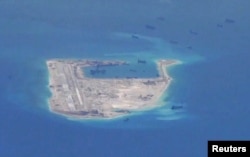Chinese officials are expected to tone down military activity in the contested South China Sea as the United States pushes back and Beijing hopes to ease Sino-U.S. trade tension without making the U.S. government angrier.
U.S. President Donald Trump wants to keep the sea open internationally as China seeks more control for itself, scholars say, and now he may be passing ships and planes into the waterway to pressure China over trade as well as its maritime activity.
“I don’t think the pressure is specifically directed toward the militarization of Chinese-owned islands in the South China Sea,” said Alan Chong, associate professor at the S. Rajaratnam School of International Studies in Singapore. “It’s more of a case trying to signal to Beijing to show some accommodation on the trade dispute.”
Since taking office in 2017, Trump has routinely sent navy vessels into the South China Sea. China has irked five other Asian governments by expanding militarily despite rival sovereignty claims.
Beijing will probably reconsider any flashy moves, such as building more artificial islands, the chief activity to date that has worried other countries, as long as the trade dispute persists and Washington keeps sending ships and planes, some scholars suggest.
“We could perhaps see that this [U.S. pressure] is not just a trade war, it is some sort of comprehensive containment policy of China,” said Oh Ei Sun, international studies instructor at Singapore Nanyang University. “It’s likely [China] will not sort of hit back hard.”
Military pressure in South China Sea
U.S. Defense Secretary James Mattis approved last year a schedule for naval vessel passages, called Freedom of Navigation exercises, to ensure they would take place without consideration for other aspects of Sino-U.S. relations, said Gregory Poling, director of the Asia Maritime Transparency Initiative under the American think tank Center for Strategic and International Studies.
China calls about 90 percent of the sea its own, giving it a lead over rival claimants in access to fisheries, fuel deposits and marine shipping lanes. Brunei, Malaysia, the Philippines, Taiwan and Vietnam claim all or parts of the sea but lack China’s military strength. The U.S. government does not claim the 3.5 million-square-kilometer sea but wants freedom of navigation to remain intact.
Other governments have bristled as Beijing parked missiles, held naval drills and considered nuclear power stations in the 3.5 million square-kilometer sea that runs from Hong Kong to the island of Borneo. Land reclamation on the sea’s tiny islets has allowed some of that militarization.
Now the U.S. ship passages, paired with at least three B-52 bomber missions under President Trump, will chill China as it vies with the United States over trade, some experts say.
The United States has levied import tariffs on $250 billion worth of Chinese goods this year, while China — which runs a trade surplus — has retaliated with tariffs on just $110 billion worth of U.S. goods, most of its imports from the other side. Economists call the dispute a threat to China’s economy.
“In this [Trump] has two purposes, one is to tell China this is not your territory and secondly put pressure on China for the trade deal, to tell them that we the U.S. are serious about this,” said Shane Lee, political scientist at Chang Jung Christian University in Taiwan.
Chinese reactions
China is trying to work out the trade dispute through talks without bringing in the maritime issue, said Carl Thayer, emeritus professor with the University of New South Wales in Australia. But Chinese officials may find it hard to know where Trump is headed on the South China Sea, he said.
“You don’t know how far he’s going to go, but since the [2016 presidential] campaign, I’ve not heard him utter the words ‘South China Sea,’” Thayer said. Beijing cites historical records to back its maritime claims.
Beijing will find it hard to do much more at sea as the trade war threatens its economy, Lee said. “With the trade war going on, they have to focus on the trade war,” he said.
More Chinese efforts to expand its maritime control would also risk “antagonizing” much of Southeast Asia, Oh said. The United States, Japan, Australia and India have tried since last year to back the Southeast Asian states over China.
Officials from Washington said earlier this year they hope Vietnam buys more U.S. weapons, and in July, two U.S. ships and an aircraft carrier held joint exercise with the Philippines in the South China Sea.














